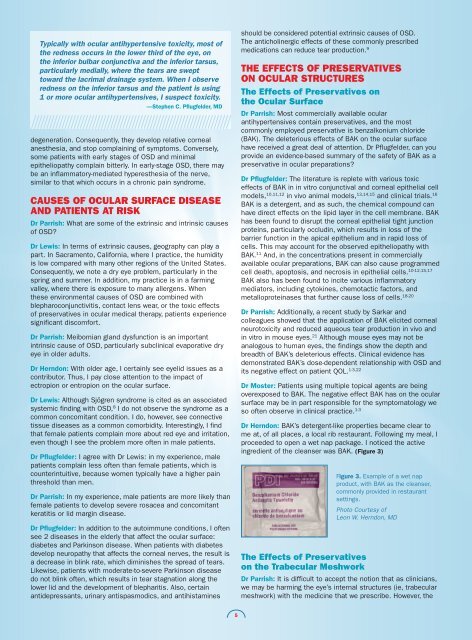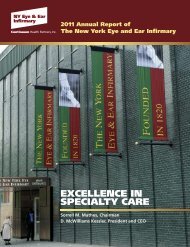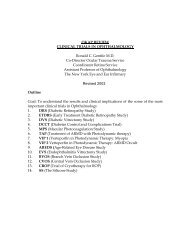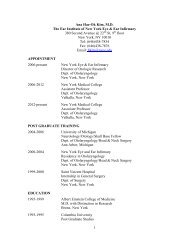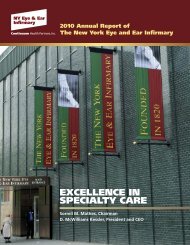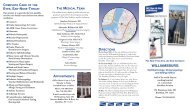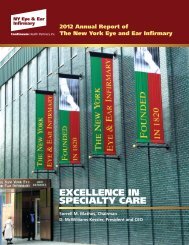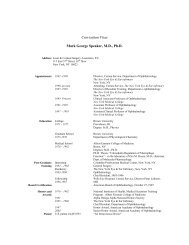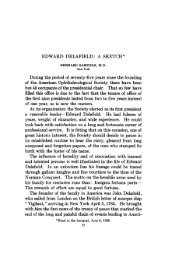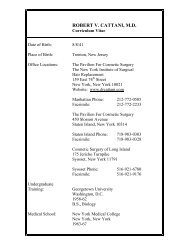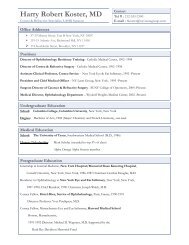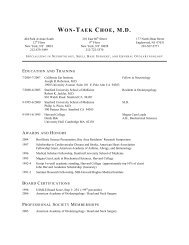The Impact on Glaucoma from the OUTSIDE IN - New York Eye and ...
The Impact on Glaucoma from the OUTSIDE IN - New York Eye and ...
The Impact on Glaucoma from the OUTSIDE IN - New York Eye and ...
Create successful ePaper yourself
Turn your PDF publications into a flip-book with our unique Google optimized e-Paper software.
Typically with ocular antihypertensive toxicity, most of<br />
<strong>the</strong> redness occurs in <strong>the</strong> lower third of <strong>the</strong> eye, <strong>on</strong><br />
<strong>the</strong> inferior bulbar c<strong>on</strong>junctiva <strong>and</strong> <strong>the</strong> inferior tarsus,<br />
particularly medially, where <strong>the</strong> tears are swept<br />
toward <strong>the</strong> lacrimal drainage system. When I observe<br />
redness <strong>on</strong> <strong>the</strong> inferior tarsus <strong>and</strong> <strong>the</strong> patient is using<br />
1 or more ocular antihypertensives, I suspect toxicity.<br />
—Stephen C. Pflugfelder, MD<br />
degenerati<strong>on</strong>. C<strong>on</strong>sequently, <strong>the</strong>y develop relative corneal<br />
anes<strong>the</strong>sia, <strong>and</strong> stop complaining of symptoms. C<strong>on</strong>versely,<br />
some patients with early stages of OSD <strong>and</strong> minimal<br />
epi<strong>the</strong>liopathy complain bitterly. In early-stage OSD, <strong>the</strong>re may<br />
be an inflammatory-mediated hyperes<strong>the</strong>sia of <strong>the</strong> nerve,<br />
similar to that which occurs in a chr<strong>on</strong>ic pain syndrome.<br />
CAUSES OF OCULAR SURFACE DISEASE<br />
AND PATIENTS AT RISK<br />
Dr Parrish: What are some of <strong>the</strong> extrinsic <strong>and</strong> intrinsic causes<br />
of OSD?<br />
Dr Lewis: In terms of extrinsic causes, geography can play a<br />
part. In Sacramento, California, where I practice, <strong>the</strong> humidity<br />
is low compared with many o<strong>the</strong>r regi<strong>on</strong>s of <strong>the</strong> United States.<br />
C<strong>on</strong>sequently, we note a dry eye problem, particularly in <strong>the</strong><br />
spring <strong>and</strong> summer. In additi<strong>on</strong>, my practice is in a farming<br />
valley, where <strong>the</strong>re is exposure to many allergens. When<br />
<strong>the</strong>se envir<strong>on</strong>mental causes of OSD are combined with<br />
blepharoc<strong>on</strong>junctivitis, c<strong>on</strong>tact lens wear, or <strong>the</strong> toxic effects<br />
of preservatives in ocular medical <strong>the</strong>rapy, patients experience<br />
significant discomfort.<br />
Dr Parrish: Meibomian gl<strong>and</strong> dysfuncti<strong>on</strong> is an important<br />
intrinsic cause of OSD, particularly subclinical evaporative dry<br />
eye in older adults.<br />
Dr Hernd<strong>on</strong>: With older age, I certainly see eyelid issues as a<br />
c<strong>on</strong>tributor. Thus, I pay close attenti<strong>on</strong> to <strong>the</strong> impact of<br />
ectropi<strong>on</strong> or entropi<strong>on</strong> <strong>on</strong> <strong>the</strong> ocular surface.<br />
Dr Lewis: Although Sjögren syndrome is cited as an associated<br />
systemic finding with OSD, 8 I do not observe <strong>the</strong> syndrome as a<br />
comm<strong>on</strong> c<strong>on</strong>comitant c<strong>on</strong>diti<strong>on</strong>. I do, however, see c<strong>on</strong>nective<br />
tissue diseases as a comm<strong>on</strong> comorbidity. Interestingly, I find<br />
that female patients complain more about red eye <strong>and</strong> irritati<strong>on</strong>,<br />
even though I see <strong>the</strong> problem more often in male patients.<br />
Dr Pflugfelder: I agree with Dr Lewis: in my experience, male<br />
patients complain less often than female patients, which is<br />
counterintuitive, because women typically have a higher pain<br />
threshold than men.<br />
Dr Parrish: In my experience, male patients are more likely than<br />
female patients to develop severe rosacea <strong>and</strong> c<strong>on</strong>comitant<br />
keratitis or lid margin disease.<br />
Dr Pflugfelder: In additi<strong>on</strong> to <strong>the</strong> autoimmune c<strong>on</strong>diti<strong>on</strong>s, I often<br />
see 2 diseases in <strong>the</strong> elderly that affect <strong>the</strong> ocular surface:<br />
diabetes <strong>and</strong> Parkins<strong>on</strong> disease. When patients with diabetes<br />
develop neuropathy that affects <strong>the</strong> corneal nerves, <strong>the</strong> result is<br />
a decrease in blink rate, which diminishes <strong>the</strong> spread of tears.<br />
Likewise, patients with moderate-to-severe Parkins<strong>on</strong> disease<br />
do not blink often, which results in tear stagnati<strong>on</strong> al<strong>on</strong>g <strong>the</strong><br />
lower lid <strong>and</strong> <strong>the</strong> development of blepharitis. Also, certain<br />
antidepressants, urinary antispasmodics, <strong>and</strong> antihistamines<br />
should be c<strong>on</strong>sidered potential extrinsic causes of OSD.<br />
<str<strong>on</strong>g>The</str<strong>on</strong>g> anticholinergic effects of <strong>the</strong>se comm<strong>on</strong>ly prescribed<br />
medicati<strong>on</strong>s can reduce tear producti<strong>on</strong>. 9<br />
THE EFFECTS OF PRESERVATIVES<br />
ON OCULAR STRUCTURES<br />
<str<strong>on</strong>g>The</str<strong>on</strong>g> Effects of Preservatives <strong>on</strong><br />
<strong>the</strong> Ocular Surface<br />
Dr Parrish: Most commercially available ocular<br />
antihypertensives c<strong>on</strong>tain preservatives, <strong>and</strong> <strong>the</strong> most<br />
comm<strong>on</strong>ly employed preservative is benzalk<strong>on</strong>ium chloride<br />
(BAK). <str<strong>on</strong>g>The</str<strong>on</strong>g> deleterious effects of BAK <strong>on</strong> <strong>the</strong> ocular surface<br />
have received a great deal of attenti<strong>on</strong>. Dr Pflugfelder, can you<br />
provide an evidence-based summary of <strong>the</strong> safety of BAK as a<br />
preservative in ocular preparati<strong>on</strong>s?<br />
Dr Pflugfelder: <str<strong>on</strong>g>The</str<strong>on</strong>g> literature is replete with various toxic<br />
effects of BAK in in vitro c<strong>on</strong>junctival <strong>and</strong> corneal epi<strong>the</strong>lial cell<br />
models, 10,11,12 in vivo animal models, 13,14,15 <strong>and</strong> clinical trials. 16<br />
BAK is a detergent, <strong>and</strong> as such, <strong>the</strong> chemical compound can<br />
have direct effects <strong>on</strong> <strong>the</strong> lipid layer in <strong>the</strong> cell membrane. BAK<br />
has been found to disrupt <strong>the</strong> corneal epi<strong>the</strong>lial tight juncti<strong>on</strong><br />
proteins, particularly occludin, which results in loss of <strong>the</strong><br />
barrier functi<strong>on</strong> in <strong>the</strong> apical epi<strong>the</strong>lium <strong>and</strong> in rapid loss of<br />
cells. This may account for <strong>the</strong> observed epi<strong>the</strong>liopathy with<br />
BAK. 11 And, in <strong>the</strong> c<strong>on</strong>centrati<strong>on</strong>s present in commercially<br />
available ocular preparati<strong>on</strong>s, BAK can also cause programmed<br />
cell death, apoptosis, <strong>and</strong> necrosis in epi<strong>the</strong>lial cells. 10-12,15,17<br />
BAK also has been found to incite various inflammatory<br />
mediators, including cytokines, chemotactic factors, <strong>and</strong><br />
metalloproteinases that fur<strong>the</strong>r cause loss of cells. 18-20<br />
Dr Parrish: Additi<strong>on</strong>ally, a recent study by Sarkar <strong>and</strong><br />
colleagues showed that <strong>the</strong> applicati<strong>on</strong> of BAK elicited corneal<br />
neurotoxicity <strong>and</strong> reduced aqueous tear producti<strong>on</strong> in vivo <strong>and</strong><br />
in vitro in mouse eyes. 21 Although mouse eyes may not be<br />
analogous to human eyes, <strong>the</strong> findings show <strong>the</strong> depth <strong>and</strong><br />
breadth of BAK’s deleterious effects. Clinical evidence has<br />
dem<strong>on</strong>strated BAK’s dose-dependent relati<strong>on</strong>ship with OSD <strong>and</strong><br />
its negative effect <strong>on</strong> patient QOL. 1-3,22<br />
Dr Moster: Patients using multiple topical agents are being<br />
overexposed to BAK. <str<strong>on</strong>g>The</str<strong>on</strong>g> negative effect BAK has <strong>on</strong> <strong>the</strong> ocular<br />
surface may be in part resp<strong>on</strong>sible for <strong>the</strong> symptomatology we<br />
so often observe in clinical practice. 1-3<br />
Dr Hernd<strong>on</strong>: BAK’s detergent-like properties became clear to<br />
me at, of all places, a local rib restaurant. Following my meal, I<br />
proceeded to open a wet nap package. I noticed <strong>the</strong> active<br />
ingredient of <strong>the</strong> cleanser was BAK. (Figure 3)<br />
<str<strong>on</strong>g>The</str<strong>on</strong>g> Effects of Preservatives<br />
<strong>on</strong> <strong>the</strong> Trabecular Meshwork<br />
Figure 3. Example of a wet nap<br />
product, with BAK as <strong>the</strong> cleanser,<br />
comm<strong>on</strong>ly provided in restaurant<br />
settings.<br />
Photo Courtesy of<br />
Le<strong>on</strong> W. Hernd<strong>on</strong>, MD<br />
Dr Parrish: It is difficult to accept <strong>the</strong> noti<strong>on</strong> that as clinicians,<br />
we may be harming <strong>the</strong> eye’s internal structures (ie, trabecular<br />
meshwork) with <strong>the</strong> medicine that we prescribe. However, <strong>the</strong><br />
5


